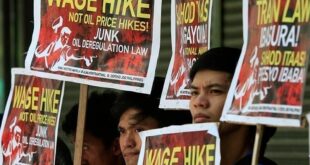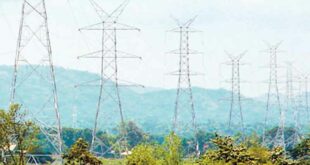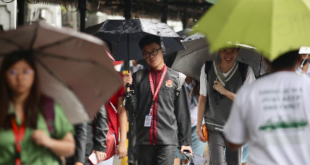
Fewer poor seen as economy opens up post-pandemic
Almost 900,000 Filipinos escaped from poverty in the first half of 2023 as the income of poor Filipinos improved with the opening of the economy following the pandemic.
The Philippine Statistics Authority (PSA) said Friday poverty incidence among the population or the proportion of poor Filipinos whose per capita income is not sufficient to meet their basic food and non-food needs was estimated at 22.4 percent or about 25.24 million people.
This was lower than the 23.7 percent poverty incidence in the same period in 2021, which meant 895,260 Filipinos were no longer poor.
The subsistence incidence among Filipinos or the proportion of Filipinos whose income is not enough to buy even the basic food needs was registered at 8.7 percent or about 9.79 million Filipinos in the first semester of 2023, lower from 9.9 percent in the same period in 2021.
PSA Undersecretary Dennis S. Map attributed the decline in the incidence of poverty to the “substantial” increase in per capita income of the first three deciles or three tenths of the poorest population in the country.
The per capita income of the first decile, the poorest 10 percent of the population, rose to P10,098 a month in 2023 from P8,318 in 2021.
The second and third deciles rose to P15,738 and P20,141 a month, respectively.
Poverty statistics are based on the Family Income and Expenditure Survey (FIES), which is held every two or three years.
Arsenio Balisacan, secretary of the National Economic and Development Authority (NEDA), said the administration was focused on achieving a single-digit poverty rate.
He also noted that the effect of opening up the economy was “much greater” for the poor.
“The decision to fully open the economy and lift all COVID-19 restrictions in the country starting in 2022 has allowed us to recover from the unprecedented, combined impact of the pandemic and the government’s policy responses to the crisis,” Balisacan said.
He also said the government’s efforts to tame inflation and manage its effects have yielded significant results.
“The high inflation in the first semester of 2023 partially offset the positive effect of income growth on poverty. We note that per capita income among those in the first income decile (the poorest 10 percent of our population) increased by 21.4 percent, and those in the second and third deciles increased by 19.4 and 18.3 percent, respectively,” he said.
“Had the inflation rate for the bottom 30 percent been at 4 percent in2021 and another 4 percent in 2022, the cumulative increase in poverty threshold would be around 8.2 percent instead of 14.2 percent.
Assuming the same increase in income, poverty incidence among the population would have been about 16 percent instead of the observed 22.4 percent,” Balisacan said.
Among families, poverty incidence was estimated at 16.4 percent, which was equivalent to 4.51 million poor families, lower from 18 percent in the same period in 2021. This means that 230,000 households escaped from poverty.
The subsistence incidence among families also went down to 5.9 percent or about 1.62 million food poor families from 7.1 percent in the same period in 2021.
On the average, a family of five members will need at least P13,797 per month to meet their minimum basic food and non-food needs, higher compared to P12,082 in 2021.
Balisaan said the administration remains focused on its priority to substantially reduce poverty to a single-digit level by 2028.
“We are making progress in poverty reduction and the growth is becoming inclusive as you can see the faster growth in income relative to other groups,” he said.
“I’m quite optimistic in the second half… the inflation is going down and the labor market condition is quite robust,” he added.
Balisacan said the government will ensure the effective implementation of various initiatives and interventions in the social sector to reduce poverty at both the national and regional levels.
“We will continue to prioritize creating high-quality and high-paying jobs to address the rising issue of vulnerable employment. To achieve this goal, we will continue to focus on attracting job-generating investments from the private sector, significantly improving humancapital, and scaling up social and physical infrastructure to improve our people’s employment prospects,” he said.
“We will ensure that our macroeconomic fundamentals are sound, enabling us to sustain growth in the medium and long term,” he added.
The Presidential Communications Office welcomed the PSA report noting that the data aligns with the administration’s commitment to achieving a single-digit poverty level by 2028.
Speaker Ferdinand Martin G. Romualdez vowed that the House of Representatives would continue pursuing and funding programs ofPresident Marcos intended to improve the lives of millions of poor Filipinos.
Romualdez made the commitment in reaction to the report of the PSA that poverty incidence in the country has dropped to 22.4 percent of the population in the first half of 2023 from 23.7 percent in the same period in 2021.
“We are happy for 900,000 of our countrymen whose situation hasimproved from being poor over the past two years. We will continue tohelp the more than 25 million get out of poverty through intervention programs,” Romualdez said.
The House leader cited the Pantawid Pamilyang Pilipino Program (4Ps), Assistance to Individuals in Crisis Situation, TUPAD (Tulong Panghanapbuhay sa ating Disadvantaged/Displaced Workers), free college education, free health insurance, and the grant of direct cash subsidies as among government intervention measures aimed at reducing poverty.
He said the House has chosen to exercise its oversight power as needed to bring down the price of rice and other staples at affordable levels by fighting inflation, smuggling, hoarding, price manipulation, and similar abusive practices.
He said Congress has included in the 2024 national budget P60 billion for a new program called AKAP (Ayuda sa Kapos ang Kita), under which 12 million poor and low-income families would receive a one-time financial grant of P5,000.
At four members per family, AKAP is projected to benefit 48 million Filipinos.
Some P500 billion in the 2024 budget has been allocated to assistance through social service-related programs.
Citing a World Bank study, he said there is concrete evidence thatdirect cash grants are an effective tool for reducing poverty among the population.
“Our own 4Ps is proof of this. Many beneficiary-families have improved their situation by producing college graduates,” he said.
He cited a new report carried by the Philippine Information Agency on Dec. 11 that 31 children of 4Ps families have recently completed their college education and have passed their licensing exams — 25 teachers, four accountants and two engineers.
As his personal poverty reduction project, the House leader has also launched CARD (for Cash Assistance and Rice Distribution).
CARD was launched in Metro Manila’s 33 legislative districts, with each having 10,000 poor and vulnerable beneficiaries for an initial total of 330,000 recipients.
The amount of assistance each recipient gets totals at least P2,000 — P950 for 25 kilos of rice at P38 per kilo and the remaining cash is for other food essentials.
— Darwin G. Amojelar, Charles Dantes & Maricel Cruz
*****
Credit belongs to: www.manilastandard.net
 Atin Ito First Filipino Community Newspaper in Ontario
Atin Ito First Filipino Community Newspaper in Ontario






